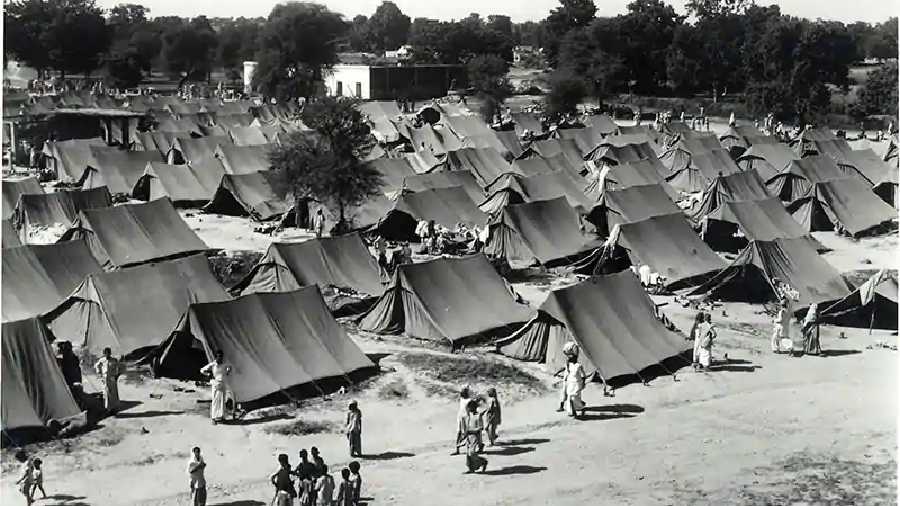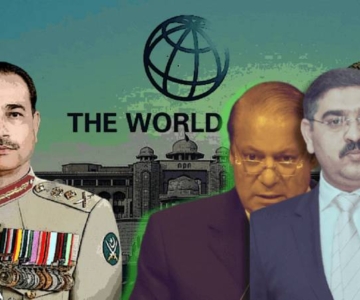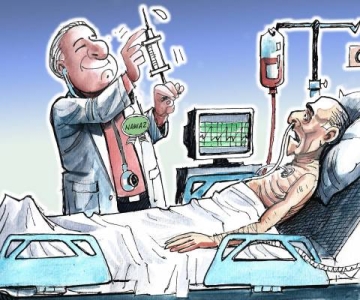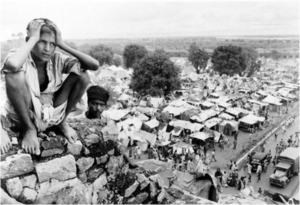
The debate on India Partition of 1947 continues even 68 years after the cataclysmic event took place. The manifestations of this historical rupture are all too evident in our present as well. For the past few months, Indian authors and intellectuals have been protesting the growing incidents of communal violence and the mainstream Indian discourse on Muslims and Islam was never so pungent. Ironically, the right wing commentators and Hindu nationalist politicians have been advising the dissenters to move to Pakistan. This would have been amusing, if it were not for the looming threat of violence physical, verbal or even imagine.
For decades, Pakistani dissenters have also been branded as Indian agents. With the rise of social media and the deep, dark havens of bigotry that the Internet provides, campaigns are launched to brand anyone deviating from the official line of Pakistan, defined by religious nationalism, as a traitor. Human rights defenders such as Asma Jahangir and even Centre-right politician such as Nawaz Sharif have been painted in such a light. At the heart of these sterile and offensive campaigns lie issues linked to identity religious, national and political. In short, the discussions that were taking place in British India of the 1940s have permeated into our contemporary discourses.
That Muslims follow a faith which originated in Arabia is overused in scholarship and politics
A key marker of nationalism is the appropriation of history. For Pakistani nationalism, a mix of religious identification and security obsession forms the basis. The Hindu majority excesses are the rationale for Pakistan existence. In India, after many decades of cultivating nationalist histories, the old idea of the grand Hindu civilization interrupted by the Muslim invaders only for eight centuries or so is taking root. The states are fully participating in these projects of continuous re-imagination and reinvention of the past to suit the kind of nationalistic fervor they wish to instill into the body politic.
Independent scholarship on Partition and the creation of Pakistan is scant to say the least. It is some measure of impoverishment that most of the work on Pakistan has been done outside the confines of the Pakistani academy and national historical institutes. Ayesha Jalal study The Sole Spokesman, published in 1985, challenged the existing narratives and set into motion a new orthodoxy of sorts. Many historians and scholars on Pakistan have been arguing around the case she laid out, ranging from endorsement to an outright demolition. This reflects the power of arguments that Jalal presented outside the domains of official national histories in India and Pakistan. Her work also demonstrated the fluidity of the tumultuous decade of 1940s and how the idea of Pakistan was almost an unsettled one even after the official declaration by the outgoing imperial power.

In 2015, three books on Partition were published that provide some fresh insights and yet reinforce the old, beaten track of historical research. An important book in this context is Creating a New Medina: State Power, Islam, and the Quest for Pakistan in Late Colonial North India, published in 2014, written by Venkat Dhulipala, who teaches at the University of North Carolina, Wilmington. The book works around a host of texts from the early twentieth century and challenges the oft-quoted verdict by Salman Rushdie that Pakistan was insufficiently imagined. Dhulipala argues that Pakistan was plentifully imagined and with ambition too as a sovereign Islamic state, a new Medina of sorts, aiming to revive Islam and the ummah. Thus, it would act as a legitimate successor to the Ottoman caliphate.
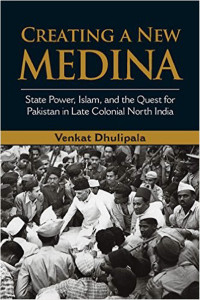 On the face of it, the argument is compelling and even seductive. After all, Pakistan trajectory after 1949 has been similar to the quest for a puritanical Islamic Republic. From the Objectives Resolution that acknowledges the supremacy of Sharia to the declaration of Ahmadiyya community as non-Muslim citizens in 1974 and from the repeated amendments to colonial blasphemy laws to stringent sectarian Islamisation of 1980s under General Zia ul Haq, the quest for an Islamic polity has been a theme of the country history. Even in the twenty-first century, the wildly popular leader Imran Khan promises an Islamic Welfare State as a slogan for new Pakistan.
On the face of it, the argument is compelling and even seductive. After all, Pakistan trajectory after 1949 has been similar to the quest for a puritanical Islamic Republic. From the Objectives Resolution that acknowledges the supremacy of Sharia to the declaration of Ahmadiyya community as non-Muslim citizens in 1974 and from the repeated amendments to colonial blasphemy laws to stringent sectarian Islamisation of 1980s under General Zia ul Haq, the quest for an Islamic polity has been a theme of the country history. Even in the twenty-first century, the wildly popular leader Imran Khan promises an Islamic Welfare State as a slogan for new Pakistan.
However, the question is whether Pakistan trajectory is rooted in its past and the fractured Pakistan movement of 1940s or was it a later, deliberate choice as the country searched for an identity. Or perhaps, it was simply a case of cynical opportunism by the civil-military bureaucracy that has governed Pakistan directly and indirectly since its inception. These are open, contentious and unresolved questions.
Pakistan may be moving away from over-reliance on religion in constructing its identity
Dhulipala observes, Jinnah repeatedly dismissed the idea that India constituted a geographical unity. India, he insisted, was divided and partitioned by nature and Muslim India and Hindu India existed on the physical map of India. Since India comprised different nationalities and the singular nation existed only in the imagination of Congress leaders who were recklessly indulging in such mental luxuries. Pakistan on the contrary, was indeed more practical than Ram Raj or Swaraj that Gandhi was advocating for India. The only solution to India problem, Dhulipala reiterates, was to partition India so that both the communities could develop freely and fully according to their own genius.
In his archival research, Dhulipala focuses on detailed readings of the works produced by Shabbir Ahmad Usmani, a Deobandi scholar who later joined the Muslim League. In 1945, Usmani created the Jamaat Ulema-i Islam, or JUI a breakaway faction of the mainstream, pro-Congress Jamaat Ulema-i Hind, or JUH. Usmani pamphlet Hamara Pakistan (1942), and the speeches he made serve as the building blocks of Dhulipala central argument. Citing other texts from this period, the book tells us how Pakistan, as an idea, was being popularized as an Islamic state in the UP. Another important document that helps this argument was the Muslim League report on a potential Islamic constitution. These narratives in the view of author bolstered the Islamic imagination of Pakistan. One has to mention here that the Muslim League report cited by Dhulipala was not widely shared or debated until after the creation of Pakistan itself. In addition, reports from colonial police records also help shape Dhulipala thesis. A Muslim League figure cited in the book who argued for an Islamic state is the Raja of Mahmudabad. It is unclear if Jinnah or other Muslim League figures at any point paid heed to this advice. If anything, Jinnah rejection of such an idea has been recorded.
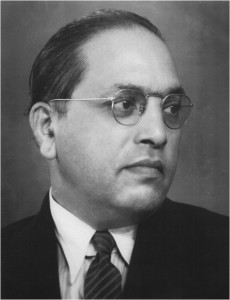
BR Ambedkar, the leader of Dalits and architect of the Indian constitution also emerges as a major reference in Dhulapianarrative. The author relies on Ambedkar book, Thoughts on Pakistan wherein Muslims are referred to as a religious threat to Hindus. Ambedkar held that Hindustan would benefit economically, politically, militarily, and socially if Pakistan were carved out of the Indian subcontinent. Cited as the philosopher of Pakistan, Ambedkar view of Muslims as exclusivist community is presented as an influence on what transpired in 1947. How far Ambedkar was influenced by colonial historians in viewing the Hindu Muslim history of India is another moot point that is not sufficiently addressed in the book.
But it is also well known that Ambedkar and Jinnah enjoyed camaraderie and the former received support from the Muslim League. Leaving aside these not-so-minor details, it should be acknowledged that Dhulipala brings back the otherwise invisible Ambedkar into the discussions on Partition.
The subaltern perspectives, however, present a different story. Ali Anwar Ansari, a leader of marginalized classes, held that Muslim nationalism was an elitist project. The views of Muslim artisans, weavers and other working class groups are largely invisible in both Indian and Pakistani narratives. For instance, in 1941, thousands of Muslims weavers organized as Momin Conference and demonstrated in Delhi against Muslim separatism. They had travelled from Bihar and Eastern U.P. These groups remain deeply religious, even today, but they seemed to have missed the theological discourse of a new Medina state.
The idea that Muslims follow a faith that originated in Arabia is overused both in scholarship and mainstream politics. Muslim imperialism in India is a concept that dates back to the historiographies of colonial historians and has been challenged within India by nationalist historians as well as the Subaltern school, which looks at the past from the perspective of folk intermingling and pulls history away from the chronicles of courtiers.
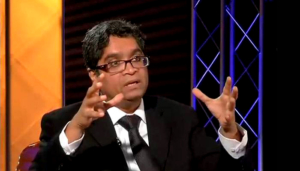
The most significant critique of Dhulipala argument is located in the evolution of secular-modernist Muslims who imbibed Western ideas of democracy and the nation-state. These figures presented a different imagination of Pakistan from that of the religious leaders. Muslim modernists also challenged religious orthodoxy itself. The religious groups and the Muslim League were two discrete political imaginations. Jinnah straddled the two, turning to the former for political mobilization. The Muslim League branded itself as a vehicle that articulated the concerns of modern Muslim elites of India. For them, maulvis and maulanas had to be kept at bay and prevented from driving politics. In post-Jinnah Pakistan, this consensus broke down.
Jinnah and others were castigated by the orthodoxy, including Maududi (who is largely absent from Dhulapia book). Another scholar, A.A.A Fyzee, was declared an apostate for asking women to break the shackles of traditional approaches to Sharia law. Syed Ahmad Khan and Iqbal, both modernists, were victims of fatwas by the same brand of clerics who later advocated a theocracy in Pakistan.
As a record of the undercurrents that influenced Muslim nationalism, Dhulipala book is immensely useful. The construction of its central argument can be challenged but the underlying contradictory themes in Pakistan imagination are important to understand. The ideal of an Islamic state was always there, but not the dominant or popular one. It is only after 1947 that the maulanas and maulvis including Maududi, who was not a supporter of Pakistan creation found an ideal ground to view themselves as the shepherds of the new state.
After Jinnah early death, the latent ideal of a theocracy was picked up and exploited by both the military and populist leaders like Zulfiqar Ali Bhutto. Pakistan struggles to grapple with a nation-state identity that can be free of sectarian divides. But the curse of geography pushed the country into the Centre of transnational jihadist movements.
What is important to remember is that the struggle and internal debate is far from being over. In fact, there are signs that Pakistan may be moving away from the over-reliance on religion in construction of a national identity. Only time will tell, but the recent de-linking of the military from the mullah is a promising development.
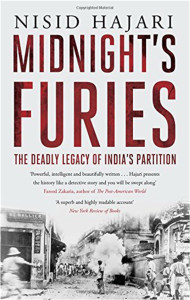 Midnight Furies, The Deadly Legacy of India Partition authored by a renowned journalist Nisid Hajari was another significant book released in 2015. This book also examines the same fractious period of our history. Nehru and Jinnah as the two protagonists of the Partition story are contrasted and compared in this study, which is based on extensive research. Midnight Furies is written for a more mainstream audience, so it invokes drama and bears the footprints of a journalist piecing together various snippets some well known, others less so. Its engaging narrative is useful for a global reader who may not be too familiar with the division of India.
Midnight Furies, The Deadly Legacy of India Partition authored by a renowned journalist Nisid Hajari was another significant book released in 2015. This book also examines the same fractious period of our history. Nehru and Jinnah as the two protagonists of the Partition story are contrasted and compared in this study, which is based on extensive research. Midnight Furies is written for a more mainstream audience, so it invokes drama and bears the footprints of a journalist piecing together various snippets some well known, others less so. Its engaging narrative is useful for a global reader who may not be too familiar with the division of India.
Hajari calls Jinnah the most polarising figure in the Partition drama and thereby reiterates the conventional line from Indian nationalist accounts of the Partition. Jinnah trepidation that India might strangle Pakistan at birth is also mentioned. This insecurity from the start continues to inform Pakistan worldview to date. While Hajari does comment on the consequences of Jinnah choices even if they were driven in part by the agreement with Congress he is not altogether uncharitable to the idea of the new state: Pakistan would be secular, not an Islamic state, its founder Mohammad Ali Jinnah promised: Hindus and Sikhs would be free to practice their faiths and would be treated equally under the law. Citing Nehru, Hajari reminds us of Nehru words: Division is better than a union of unwilling parts.
The unseemly haste with which the British left India is also described well in the book and most importantly, Hajari portrays the horrors that included nearly a million dead and the biggest forced migration in history. In his account he strives for a balance, so massacres by Sikh, Hindu and Muslim thugs get equal mention.
The book also enters into a polemical debate on putting the midnight furies to rest. And perhaps this is where its relevance is most noteworthy. Both countries, now nuclear armed, have been mired in continued conflict and this poses a risk, not just to one-fifth of humanity (i.e. South Asia) but to global security as well.
Midnight Furies however focuses on Punjab and its coverage of what happened with the Partition of Bengal leaves much to be desired. Also, the fact that the Pakistan movement popular roots were in East Bengal (now Bangladesh) is scantily touched upon. This is where the narrative of both the books falters.
Muslim nationalism of the early twentieth century was not restricted to religion alone. In East Bengal, Pakistan was popular for other chiefly economic reasons and this missing bit of Pakistan story is important. Both Dhupalia and Hajari don’t provide a clear explanation as to why the Cabinet Mission Plan was rejected by Nehru. Maulana Azad has been critical of Nehru and Congress in scuttling the idea of a confederated India. Given how India and Pakistan have struggled with their federal question and upheld an over-centralized form of governance for many decades, this discussion becomes even more important.
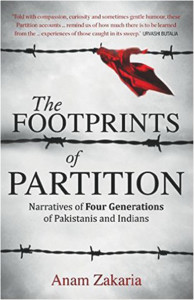 Anam Zakaria The Footprints of Partition: Narratives of Four Generations of Pakistanis and Indians comes out of an oral history project that Zakaria was leading before she started to write her book. Her book, unlike other works of this genre, stands out for its emphasis on the authentic voices of four generations of Pakistanis and Indians who share cultural memory. So she places the Partition narratives in a wider perspective of human loss.
Anam Zakaria The Footprints of Partition: Narratives of Four Generations of Pakistanis and Indians comes out of an oral history project that Zakaria was leading before she started to write her book. Her book, unlike other works of this genre, stands out for its emphasis on the authentic voices of four generations of Pakistanis and Indians who share cultural memory. So she places the Partition narratives in a wider perspective of human loss.
Using seventeen long interviews, largely Punjab- and Mumbai-based, Zakaria weaves a compelling narrative that places people rather than elite interests at its centre. The headings of the book four parts Azad Qaidis, When Home is Elsewhere, A Museum of Memories and Bharat say Rishta kya? are instructive as they symbolise journeys into the past as well as the present.
As a young woman who received her education and much of her consciousness within Pakistani discourses of the other, Zakaria personal narrative is a vital component of the book. She relates how younger Pakistanis express their fear and derision of Hindus and Indians. Her work, both as an archivist and as a writer, enabled her to view the past in a more holistic fashion. This is a vision of the past which does not regurgitate the idyll that many writers have woven, but is much more nuanced.
A young Pakistani raising all these questions especially about the traumatic, manipulated collective memory of mass violence, rape, plunder and pillage is refreshing. While Zakaria interviews and commentary dwell on the ruptures and fissures of 1947, she is also an astute observer of indigenous cultures that are far more resilient than what the states imagine.
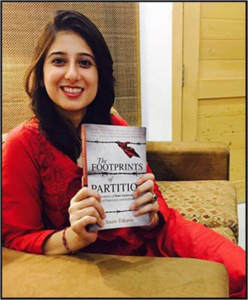
While travelling to Sheikhupura a small town close to Lahore Zakaria finds out about an old festival at a shrine that continues to be held even after 1947. People from both sides attend it and participate even if it is across a border. The border, which brings together people for reasons of faith, ironically owes its existence in the first place to faith-based identities.
It should be highlighted that Zakaria does not challenge Partition per se, nor even critiques the two-nation theory. What The Footprints of Partition essentially achieves is to gather and process personal stories of people with cataclysmic experiences: leaving the reader free to make sense of whatever idea of history they wish to imbibe.
India, Pakistan and Bangladesh need to exorcise the ghosts of their past
The real heroine of this book is Zakaria herself. Devoid of bitterness, engaged in a self-confessed process of learning and unlearning and honest to the core she confirms that Pakistan’s youth are capable of resetting the future of the country. And that would entail, in the first instance, reclaiming the past in a manner that avoids half-truths and false constructions. Zakaria has been to India several times but she did not visit Batala, the city where her father’s family comes from. This by itself represents an intergenerational shift: getting over a blood-stained, shared past. Instead of glorifying or demonising that past, why not simply confront it with integrity and empathy?
India, Pakistan and Bangladesh need to exorcise the ghosts of their past. To develop a more integrated vision of our multi-layered past, it is important to disengage historiography from nationalism. Not unlike France and Germany, we need to think of a commission on rewriting what we teach our children and peddle as the truth.
